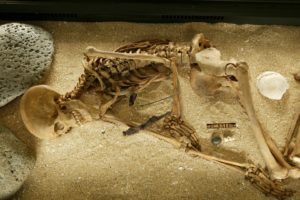
AMERICAN ASSOCIATION FOR THE ADVANCEMENT OF SCIENCE—Two separate studies – both benefiting from ancient DNA – paint detailed pictures of the founding, migration, and evolution of human populations in Iceland and the Americas, respectively.
More broadly, the plethora of historical information from ancient DNA studies such as these represents a new era of archaeogenomics, say Alessandro Achilli and colleagues in a related Perspective. The ability to study the founding of a human population and its subsequent evolutionary history is rare, but here, S. Sunna Ebenesersdóttir and colleagues were able to make progress on this, providing detailed insights into the making of Icelandic populations specifically. The researchers used genome sequencing data from the skeletal remains of 27 ancient Icelanders – the earliest settlers of Iceland, according to radiocarbon dating. Perhaps not unexpectedly since Iceland was peopled in early times by Vikings and enslaved individuals from Norway and the British-Irish Isles, all ancient Icelanders, the authors found, were Norse (Norway and Sweden), Gaelic (Ireland and Scotland), or a mixture. Surprisingly, however, the ancient Icelanders were much more similar to their source populations in Scandinavia and the British-Irish Isles than to modern Icelanders, comparisons with modern European DNA revealed. One explanation for this, the authors hypothesize, is that roughly 1,100 years of genetic drift (or, a change in the frequency of certain genes due to random happenings) have shaped Icelandic populations to what they are today. Intriguingly, the high degree of mixture in the Norse and Gaelic gene pool of ancient Icelanders may account for why modern Icelandic populations are exceptionally good candidates for studies that attempt to associate genes to traits. The high genetic variation resulting from this ancestral mixture is more desirable for genome-wide association studies, compared to more homogenous populations, for which it is difficult to tell which region of DNA causes a specific trait.
The second study by Christiana Scheib et al. explores the genetics of the first people to enter the Americas, providing evidence, through its results, that a deep split in North and South American populations likely occurred not in Beringia, as has been posited, but just south of the ancient Laurentide ice sheet (which covered a large portion of the northern United States, including most of Canada). Scheib and colleagues sequenced 91 genomes of ancient Native American remains predominantly from California and Southwestern Ontario, Canada. They found that ancient Ontarians were most like other ancient Northern Americans as well as modern Algonquian-speaking Native Americans. In contrast, genomes from ancient Californians resembled groups that currently live in Mexico and South America. Based on these findings, the authors reject the emerging theory that the split between Northern and Southern Americans occurred in Beringia, across the Laurentide ice plate, and suggest that a single wave of Ice Age American populations migrated south of the Laurentide ice plate and a genetic split likely occurred after this crossing, at the northwest corner of ancient North America. Notably, the researchers also found both ancient Californian and Ontarian DNA present and mixed throughout Northern and Southern regions. Thus, the authors suggest that there were possible points where the two diverging branches merged either in North America or along the migration route to South America, at least a few thousand years after the initial split.
________________________________

Skeletal remains of an ancient pre-Christian (<1000 C.E.) Icelandic female. This material relates to a paper that appeared in the 1 June 2018 issue of Science, published by AAAS. The paper, by S.S. Ebenesersdóttir at deCODE Genetics/AMGEN, Inc. in Reykjavik, Iceland, and colleagues was titled, “Ancient genomes from Iceland reveal the making of a human population.” Ivar Brynjolfsson / The National Museum of Iceland
________________________________
Article Source: AAAS news release
________________________________



